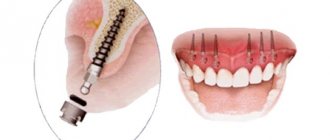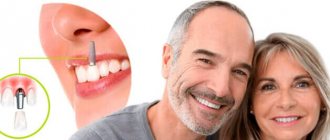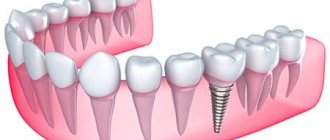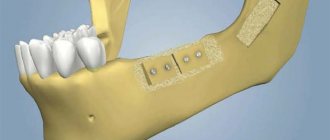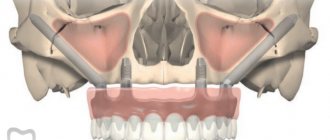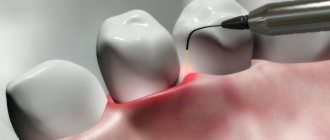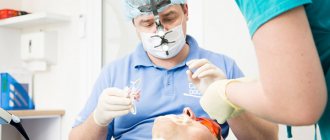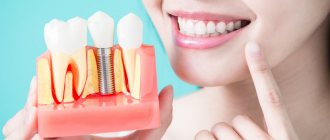What is implantation?
This dental procedure is one of the most difficult. It includes several stages, and the very first is the procedure for implanting the structure into the jaw.
The product is a thin metal rod, the length of which is 0.8-1.8 cm . Due to the special structure and the presence of threads, the implant easily fits into the porous bone structure.
Important! If a person does not follow the rules of hygiene and cannot give up bad habits, then even the highest quality sample will not take root.
Complications in a smoker after implantation
Despite their high cost, Mis implants are the most convenient and comfortable prostheses to wear. After healing, the orthodontist attaches an abutment and a crown made of the selected material to the pin. After 3–6 months, a person becomes completely accustomed to wearing the structure, does not restrict himself in food, speaks confidently and smiles. Given the almost lifetime warranty on many brands of pins, the service is attracting more and more customers.
If the patient understands the risks, but is not ready to give up the bad habit, he should be aware of the possible complications that smoking brings with dental implantation:
- In smokers, the regeneration process is 50% slower than in an ordinary person. Therefore, it is more difficult for them to withstand giving up solid foods, sweets, and drinks. Violation of recommendations leads to non-healing wounds, suppuration of sutures and other problems with the gums.
- Bone tissue weakened by toxins sometimes cannot withstand the implant, breaks or rejects it after a few weeks. Such patients more often require sinus lift and other strengthening procedures.
- Tar and nicotine accumulate in saliva. If they reach a metal rod through an unhealed wound, oxidation begins. In this case, it is no longer possible to save the structure.
- Smoking provokes too sharp pressure surges in the capillaries, which is why bleeding, painful bruises and severe swelling around the artificial crown often occur.
- Dehiscence of the applied suture due to the high temperature of the smoke in the mouth.
After each puff, plaque remains on the inside of the cheeks and teeth. As it accumulates, it turns into stone and puts pressure on the gums, causing inflammation. If hard particles are not removed in a timely manner, they increase the weight of the crown and put pressure on the pin. This can cause rejection at any stage of implantation.
In a smoking patient, the likelihood of developing peri-implantitis increases by 40% due to frequent burns of the mucous membranes. An abscess appears on the gum near the implant, which puts pressure on the rod from the inside, displaces it from its axis and provokes mobility.
Why can't you smoke after dental implantation?
According to static data, rejection of the installed structure in smokers occurs 2 times more often than in non-smokers . From this we can conclude that in 8% of the total number of smoking patients the implant will not take root. But this does not mean that smoking and implantation are incompatible concepts.
Tobacco smoke has the following effects on the installed product::
- With regular smoking, inhalation of smoke can lead to burns of oral tissues , resulting in hyperkeratosis of the oral mucosa and slowing down reparative processes in it. This contributes to slow gum healing and increases the risk of developing peri-implantitis .
- Smoking disrupts the functioning of the salivary glands and leads to the development of chronic dryness of the oral mucosa . This not only worsens the gum healing process, but also accelerates the development of pathogenic microflora, as a result of which the implant begins to be rejected.
- Nicotine and its byproducts have a detrimental effect on the peripheral blood vessels found in the oral mucosa and on the surface of the bone layer. Tobacco smoke leads to increased sensitivity, prolonged spasm of these vessels, as a result of which the speed of blood flow slows down and the amount of oxygen and nutrients supplied to the tissue decreases . Ultimately, the implant does not take root in the bone.
Attention! All of the above factors have a bad effect on the healing process after installation of the structure, and also worsen the local immunity of the oral mucosa.
This increases the amount of pathogenic microflora and leads to the development of an inflammatory process in the tissues located near the implant.
Addiction after engraftment
No doctor has the right to prohibit or prevent smoking. They can only advise you to give up this habit, justifying their words with weighty facts.
Many patients resume their original rate of smoking immediately after the implant has taken root. This is dangerous due to the gradual decrease in bone volume in the area where the system is implanted. Naturally, this process also occurs among those who adhere to a healthy lifestyle, but much more slowly.
If you return to smoking, then quite soon (after one and a half to two years) you can independently notice the result of a decrease in gum tissue, as a result of which the core of the structure is exposed. This picture is quite unattractive, especially when artificial elements are installed in the frontal zone.
Even in case of successful engraftment, a smoker always has a risk of developing peri-implantitis. There is a loss of bone volume, swelling and a change in the shade of the gums around the system.
Therefore, if the desire to have a beautiful smile comes first, you should not return to smoking, even after a successful outcome of implantation.
Consequences and complications
Smoking and implantation are most often incompatible due to the great harm that nicotine causes to organs located in the oral cavity.
Consequences of an addiction:
- High smoke temperature . Under its influence, the enamel loses its quality, becomes dark and cracks. There is a high probability of its destruction. Material that has cracks wears out much faster.
- Nicotine and tar have a negative effect on bone tissue . It becomes thin and loses its qualities. The installed structure in such fabric is not able to firmly attach itself and is torn away.
- Nicotine has a detrimental effect on the immune system . This leads to the development of an inflammatory process in the oral cavity. A common consequence of smoking after implantation is osteomyelitis of the jaw.
- Smoking is one of the most common causes of construction failure . This can occur at any stage of wearing an artificial tooth.
- Tobacco smoke can form thick plaque and tartar . This is an excellent environment for the proliferation of pathogenic microflora, which greatly weakens the entire jaw system.
People who cannot give up this bad habit experience increased salivation.
It irritates the mucous membrane and enamel, leading to the development of numerous diseases.
Dentists' recommendations
To reduce the possibility of implant rejection, dentists advise smokers to take oral care as responsibly as possible. Proper cleaning, proper operation, and careful handling of the systems extend the period of full functionality.
Particular attention should be paid to the high-quality removal of plaque, since it is not only the cause of a disgusting odor, but also a place for the proliferation of dangerous microorganisms.
When brushing your teeth with a brush, you need to remember that the bristles should be soft so as not to injure the soft tissues surrounding the systems. Also, do not press the brush too hard on the structure.
In addition to a high-quality paste and cleaning brush, it is recommended to regularly use a waterpik. Under the influence of a jet of water, all food remains are washed away, even from remote and hard-to-reach areas.
Excellent helpers in the fight to keep teeth clean are mouthwashes, dental brushes and flosses. A specialist will tell you how to choose them correctly.
Visits to the dentist should be regular, at least once every 6 months.
Smoking patients cannot do without professional dental cleaning. This procedure is especially necessary for them, since the negative impact of tobacco smoke and nicotine tar is very great.
The video provides information about the effect of smoking on implants.
Popular questions
Despite the negative effects of nicotine, smoking and implantation can be compatible. For this purpose, special methods for implanting an artificial tooth , design models and some recommendations have been developed that will minimize the risk of developing unpleasant consequences.
Is it possible to smoke before implantation?
The duration of smoking has a strong influence on the quality of implantation of the structure and bone . There are a number of cases when the process of osseointegration of the implant does not occur in experienced smokers. The frequency of smoking in the last 3-4 weeks before surgery also affects the implantation of an artificial tooth.
Is it possible to smoke after the procedure?
Nicotine after surgery has a bad effect on the healing process and increases the risk of developing an inflammatory process and early loss of the implant .
Important! The risk of artificial tooth rejection and the frequency of consequences in smokers is high if a person cannot give up the addiction in the first 3-4 weeks after the implantation.
It is during these periods that peri-implantitis most often develops.
Is it possible to smoke after implantation and after how long?
Recently, studies were conducted in which patients with dental implants took part. They were divided into 2 groups: smokers and non-smokers.
As a result of research, it was found that smoking increases the annual rate of bone loss near the neck of an artificial tooth by an additional 0.16 mm/year .
This is not a big number, but it is important to understand that the process of bone loss occurs normally without smoking. Therefore, nicotine will speed up this process by another 0.16 mm/year. The development of peri-implantitis in smokers can occur at the final stage of engraftment .
X-rays will show bone loss. The gum located near the artificial structure swells, becomes red or bluish in color, and purulent discharge is released from under it. There are cases when peri-implantitis occurs without visible symptoms.
Selecting an implant model to reduce side effects
To prevent or reduce the risk of developing unpleasant consequences, smokers must choose the right artificial tooth model.
For your information! The success of implantation is based on the special properties of the surface of the structure, and the surfaces of products from different manufacturers differ.
There are models of implants in which the surface has active properties. They stimulate osteogenesis on the surface of the structure . This allows you to compensate for the effects that occur under the influence of nicotine.
technologies impart active properties to structural surfaces :
- the presence of an ultra-hydrophilic surface;
- treatment of the structure with fluorine ions;
- the presence of a thin layer of phosphorus molecules on the surface of the artificial tooth.
All these parameters are typical for implants from the following manufacturers :
- AstraTech;
- NobelBiocare;
- Straumann;
- Osstem.
Reviews
Below are some reviews. If you have something to say, leave your feedback in the comments below the article, it will be useful to our readers.
Igor, 57 years old, Voronezh: “I am a heavy smoker, but when it was necessary to install an implant, I was forced to give up the addiction, albeit temporarily. After installing the artificial tooth, I did not smoke for 2 months, and then began to smoke 1-2 cigarettes a day. The implemented design took root perfectly, and no complications arose.”
Mikhail, 49 years old, Moscow: “But I didn’t understand why I couldn’t smoke and couldn’t give up cigarettes, so the implant was only able to take root 3 times. Before this I had to suffer a lot. The doctor offered me 2 options - stop smoking or choose a more expensive design model, and also adhere to a number of recommendations. Of course, I chose the second option. After installing an artificial tooth for the 3rd time, I tried for 3 weeks to smoke less often than usual. This helped me get the desired result.”


